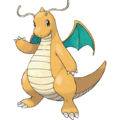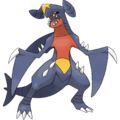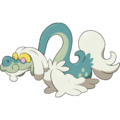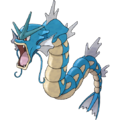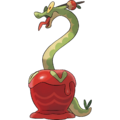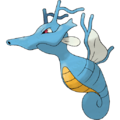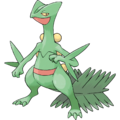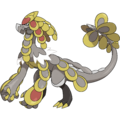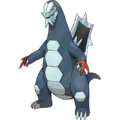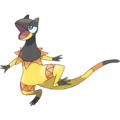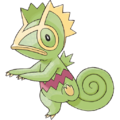User:Mister Wu/An Insight into the Dragon Egg Group
The concept of dragon in the Pokémon universe is pretty unclear. While in the recent generations Dragon-type Pokémon are usually referred to as dragons (see for example how Raihan calls his Duraludon), it should be remembered that even Pokémon that are not Dragon-type are referred to as dragons, the most notable cases being Seadra and Kingdra, the Dragon Pokémon.
But while the criteria of establishing what is a dragon and what is not a dragon in the Pokémon world are not very clear, three grouping can at least be made which officially bear the Dragon name in them:
- The group of the Dragon-type Pokémon
- The group of the Dragon Pokémon as in Pokémon category
- The Dragon Egg Group
This latter group is what caught my attention, since a lot of my favorite Pokémon are there. Plus, all of the Dragon Pokémon belong to said group, while not all of them are Dragon-type, making this group even more interesting. At this point, trying to understand why Pokémon were put into that group became quite fascinating for me. After a very little research on my part and a much bigger help from the Trivia section of the various Pokémon pages in this wiki, I think a few general groups and a few exceptions can be made, that I'll now try to describe in this subpage.
Important note: in almost every case, only the fully evolved member of each evolution family is considered, as effectively the reason of the inclusion of the whole family in the Dragon Egg Group can be seen in said species, this being particularly evident in the case of Gyarados and Milotic. The only exception is made for Seadra, since it was aadded in a different generation from Kingdra and since it was known as Dragon Pokémon even before the addition of the latter and the introduction of the Dragon Egg Group.
Main groups
Dragons
As the name implies, many Pokémon in the Dragon Egg Group look like dragons, and this aspect alone can be seen as the reason why they are in this group:
Western dragons
Wyverns
Sea serpents
Large serpents
One thing that can be noted is that with more recent generations the design tended to steer away from the typical dragon designs, this being especially noticeable in the cases of Dragapult and Flapple.
Seahorses and seadragons
In Japanese culture, seahroses are often associated with dragons, and some species related to seahorses are effectively known as seadragons. This can easily explain the presence of these seahorse-like Pokémon in the Dragon Egg Group:
As noted before, this connection between these marine animals and dragons is so strong that Horsea and Seadra were known as Dragon Pokémon even before the Dragon Egg Group existed and before the Dragon type Kingdra was introduced.
Dinosaurs
In Japanese, dinosaurs are known as Kyōryū (「恐竜」), which means scary dragons. Effectively, while the shift from Lizardo to Lizardon might be seen as the first case of a reference to this peculiar aspect of Japanese language, with -don being a typical suffix used for dinosaur names and thus for dragons as well, the first true dinosaur-like Pokémon can rather be seen in Sceptile, with Haxorus being currently the first Pokémon in this group that was confirmed to be based on dinosaurs.[1] Quite a few Pokémon in the Dragon Egg Group can be seen as being derived from dinosaurs:
It should be noted that, apart for the case of Sceptile, the addition of dinosaurs to the Dragon Egg Group is relatively recent, historically the Monster Egg Group featured most dinosaur-like Pokémon.
Exceptions
Dragon turtle
This case is not a true exception, but rather a Pokémon that simply doesn't belong to any of the above groups. It's Turtonator:
Turtles usually belong to the Water 1 Egg Group, with Drednaw confirming this trend as well. While the fire and volcanic motifs can be seen as reasons why the Water 1 Egg Group didn't suit Turtonator very well, they alone aren't a good reason for its inclusion in the Dragon Egg Group. A better reason is more likely to be found in the dragon turtle, a turtle with the head of a dragon of Chinese myth. It's quite possible that Turtonator is inspired by said dragon turtle, as reflected by its Dragon-type as well.
Lizards
In the Japanese language, there is a distinction between dragons, known as either Doragon (「ドラゴン」) or Ryū (「竜」), and lizards, known as Tokage (トカゲ). Therefore, it might be surprising to see a few lizards in the Dragon Egg Group. As we'll see, for two of them we can see a reason to be in this group other than their "lizardness". To investigate it, it will be better to deal with each of them separately.
The first fully-evolved Pokémon in the Dragon Egg Group that only resembles a lizard and not one of the creatures listed before is Scrafty:
This is also the only Pokémon for which I can't find a clear reason of being in this group. Effectively, at the moment its design inspirations aren't very clear as well, with only the mohawk suggesting a punk subculture motif and the official developer interview naming low-worn baggy pants as the concept around which the evolution family was designed.[2]
Fortunately, for the next one a clearer reason can be found. It's the Pokémon Heliolisk:
Its Japanese name, Elezard, tells us that this Pokémon is based on a lizard, and effectively it resembles the frilled-necked lizard. Since said species is known as frilled dragon as well, it's not surrpsing to see this lizard added to the Dragon Egg Group.
The last one has an interesting connection to dragons. It's Salazzle:
Her Japanese name, Ennewt, tells us that this Pokémon takes inspiration from newts, in particular the fire belly newts. However, its category, Toxic Lizard Pokémon, also tells us that this Pokémon is based on lizards. And indeed, this Pokémon has a few features in common with the Mo'o, a dragon lizard of Hawaiian myth: the black-colored body, the female gender and the connection with fire, as the Mo'o appeared when fires were lit on altars. These elements in common with Mo'o can be seen as the reason why Salazzle was included in the Dragon Egg Group.
It is important to note that a few Pokémon related to lizards were not included in the Dragon Egg Group, the most notable cases are the following:
The case of Inteleon is particularly interesting, as while based on a chameleon like Kecleon, it has a few features of flying lizards, most notably the membranes used to glide. Since flying lizards are known as flying dragons and their genus is known as Draco, it might have seemed straightforward to add it to the Dragon Egg Group, but apparently the same rationale that kept Kecleon out of the that Egg Group was applied and Inteleon became part of the Field Egg Group instead. It has to be clarified yet if this is just due to chameleons not deemed to be similar enough to lizards or if being based on lizards is just not enough of a reason to be in the Dragon Egg Group.
When the name means a lot? The bizarre case of Altaria
The last Pokémon left to investigate is perhaps the most surprising. It's Altaria:
While its appearance might be influenced by the mythical bird Peng, it isn't too farfecthed to consider this Pokémon a bluebird (of happiness). And effectively, its Japanese is Tyltalis, which reminds Mytyl and Tyltyl, the protagonists of L'Oiseau bleu, a Belgian play about the Blue Bird of Happiness. Then why is this Pokémon Dragon type and part of the Dragon Egg Group? So far the only connection seems to be in the Japanese name: Tyl is a star also known as Epsilon Draconis, of the Draco constellation. Since the Pokémon has Tyl in the name, this can be seen as the reason why Altaria was related to dragons and thus given the Dragon type and included in the Dragon Egg Group. As an aside, the localization of its name in the West couldn't preserve this reference, making the relationship between Altaria and dragons quite puzzling for the people in the Western countries.
Conclusions
Considering how much I like many Pokémon that are in this group, trying to delve into the reasons of why certain Pokémon belonged to this group lead to many nice and surprising discoveries. And a few discoveries still have to be made, in particular regarding Scrafty. I hope the explanation of what I had discovered so far wasn't excessively boring and unclear, and apologize if it was.

